Undoubtedly, the frilled lizard is one of the quirkiest sights in nature, from the moment it runs away on its hind legs to when it unfurls the colorful skin flap around its head.

Frilled Lizard
Chlamydosaurus kingii
Frilled Lizard Scientific Classification
- Kingdom: Animalia
- Phylum: Chordata
- Class: Reptilia
- Order: Squamata
- Family: Agamidae
- Genus: Chlamydosaurus
- Species: Chlamydosaurus kingii
Frilled Lizard Appearance
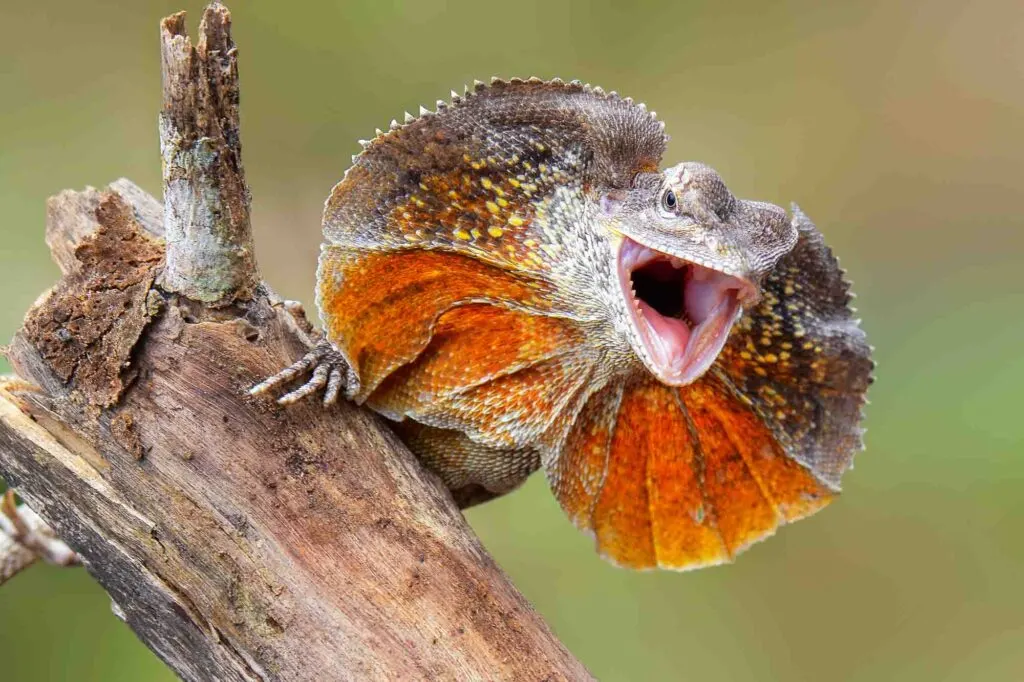
- Lifespan: up to 20 years
- Length: 3 feet
- Weight: 1.1 to 2.2 pounds
- Top speed: up to 30 mph
The frilled lizard, also known as a frilled dragon, is a large reptile commonly found in Australia and New Guinea. In the Agamidae family, it is second only to the sailfin dragon in terms of size.
A lizard with frills can grow to about 3 feet in length head to tail and weigh up to 2 pounds. The frill itself is a large, colorful, circular membrane of skin that projects both upwards and outwards from the lizard’s neck.
Adult males are often larger than females. This reptile is a lizard with a twist, sporting a frill around the neck, claws, and a long tail. Beyond the yellow or pink mouth lining, frill-necked lizards have no fixed color, with variations occurring from one environment to another.
Frilled dragons in captivity have been known to take on the coloration of their enclosure. In general, they’re predominantly brown or gray, with spots of other colors mixed in depending on location. Frilled dragons are masters of camouflage, adopting any color that matches the bark of the nearest tree they call home.
The neck frill for which it is named is usually a shade of orange and lies flat over the lizard’s shoulders. The frill’s width is roughly equal to the lizard’s body length.
However, the reptile can spread this frill when threatened to achieve a threatening posture that makes it look much bigger than it is. Its tail, which the lizard can hold above its body when threatened, has pale grey stripes at the tip.
Did you know? The frilled lizard can run standing up on its hind legs with its forelegs and tail in the air.
Frilled Lizard Range & Habitat
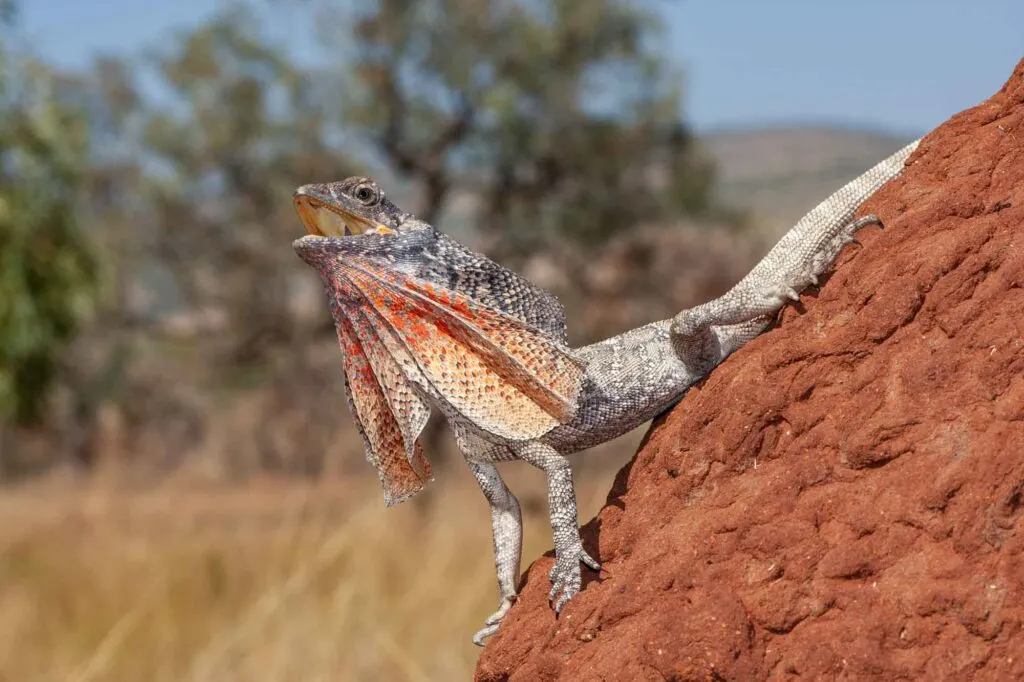
Frilled-neck lizards are native to Australia and Papua New Guinea. They can be found mainly in northern Australia and on Papua New Guinea’s southern coast.
As tree-dwelling animals that traverse the floor only when searching for food, they’re more abundant in tropical grasslands and forests.
While they generally favor humid environments, these lizards have also been observed living in the Australian desert. Frilled lizards also live with humans as pets.
Distribution
- Continents: Asia, Oceania
- Countries: Australia, Indonesia, Papua New Guinea
Habitats
Forest | Savanna | Artificial/Terrestrial
Frilled Lizard Behavior and Lifestyle
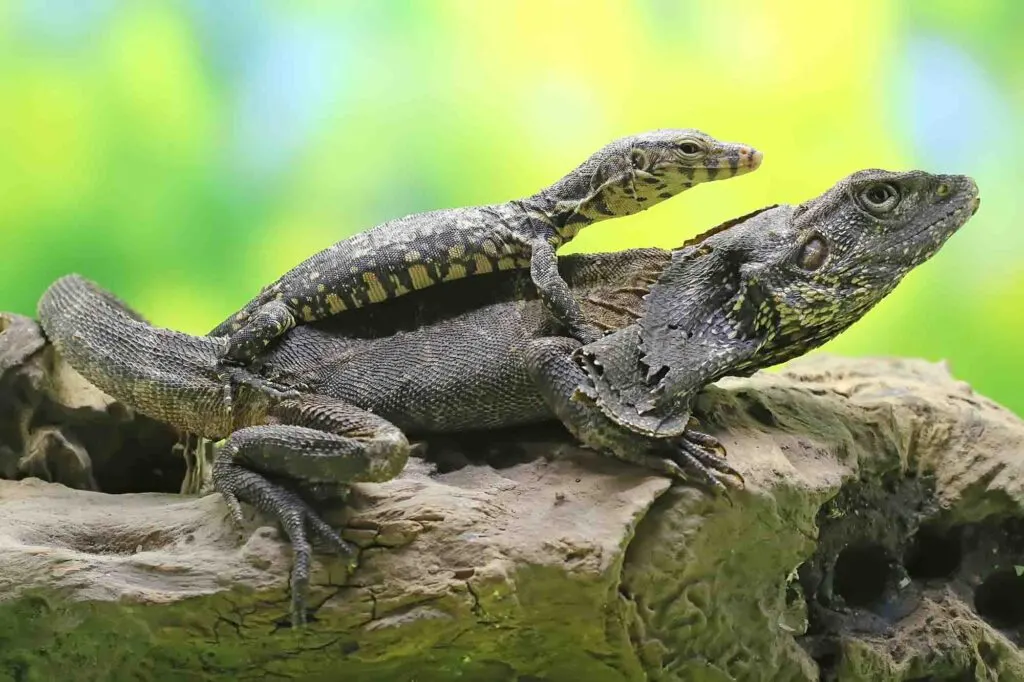
Frilled dragons are solitary reptiles, spending more of their time in trees (arboreal lizards) and only interacting with one another in the breeding season.
Frill neck lizards are territorial animals; males frequently engage in territorial conflicts on the ground and trees. They are primarily active in the daytime when they can bask in the sun and easily avoid predators. Basking is a significant feature of a frilled lizard’s lifestyle.
A lack of vitamin D and calcium causes them to lose appetite and fall ill. As an exothermic animal, sunbathing is also essential for balancing the frilled dragon’s body temperature. These reptiles extend their frills when sunbathing, enabling them to absorb a lot of heat within a short period.
Due to the hydration the rain provides, frilled lizards are more active in the wet season, eating and running significantly more than they do in the dry season. Frilled-neck lizards are swift runners, their claws allowing them to grab onto a tree trunk and move around in quick bursts.
When threatened, the frilled lizard displays startling defensive behavior, extending its frill and hissing violently. This reptile employs bipedal locomotion to escape predators, standing upright on its hind legs and running away with a cycling gesture that has earned it the ‘bicycle lizard’ nickname.
Frilled Lizard Diet
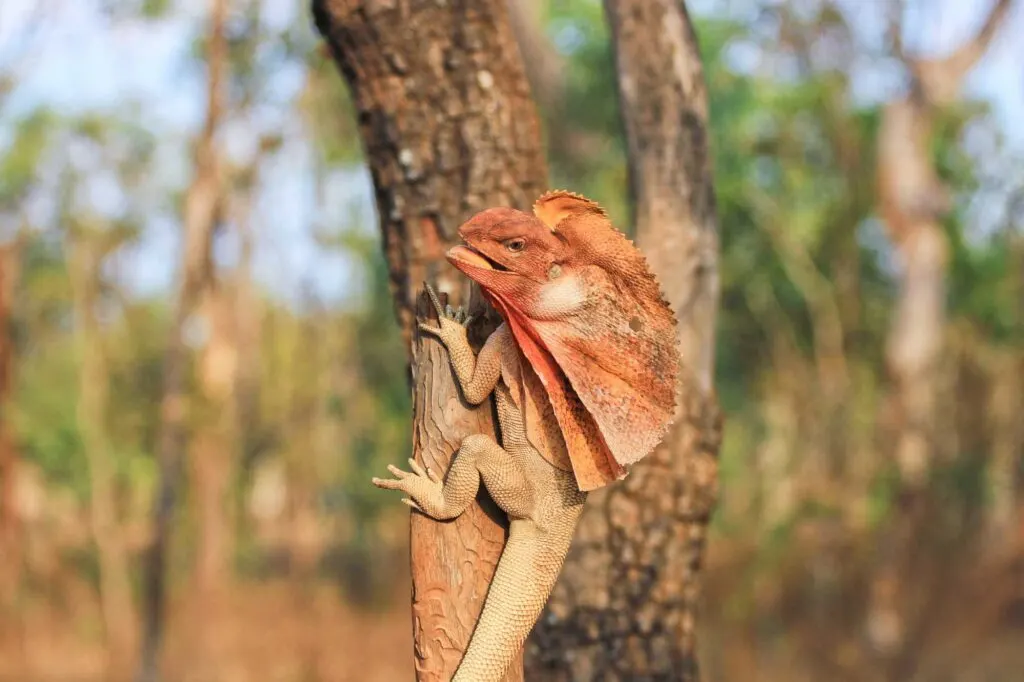
Like many lizards, drilled dragons are carnivorous animals whose primary food source is insects. In addition to beetles, termites, and cicadas, they regularly eat moths and butterflies as well as their larvae.
Spiders, mice, and even other lizards are also not off the menu for these reptiles. In captivity, frill-necked lizards have been known to consume vegetation occasionally.
Frilled lizards often hunt at dawn and dusk and do not chase prey when hunting. Instead, they put their camouflage to good use by lying in ambush and grabbing the prey when it appears.
These lizards eat abundantly, especially in the wet season. A frilled lizard can eat hundreds of thousands of termites and ants at once and then go without food for months.
The frilled lizard, however, needs more than food to survive. These animals require a certain amount of ultraviolet light daily in order to keep up their energy levels.
Frilled Lizard Reproduction and Mating
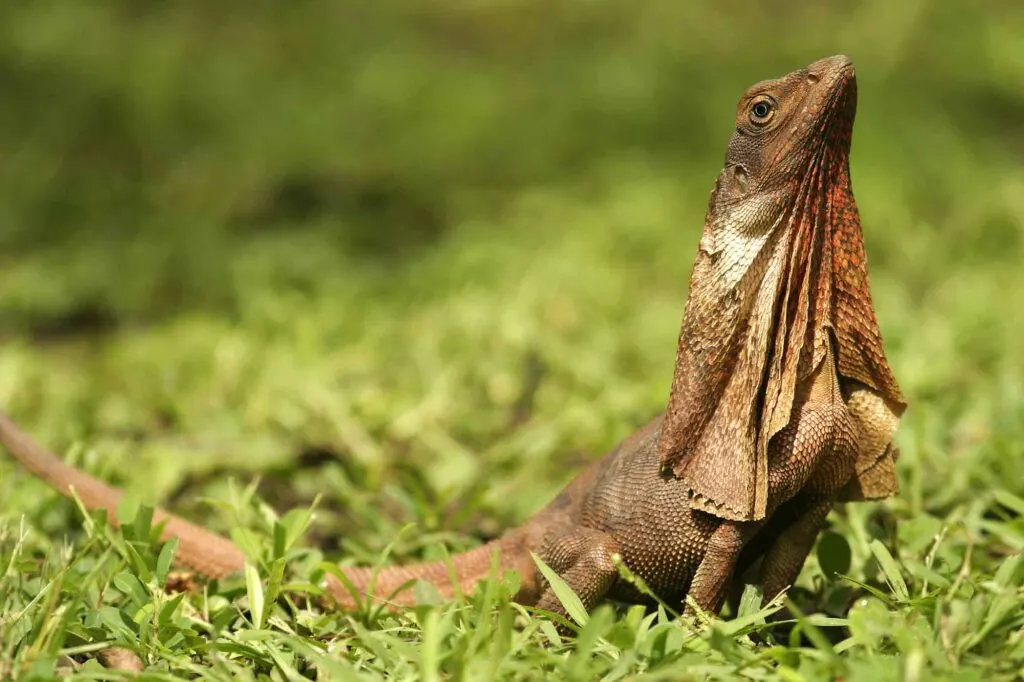
In September, the start of the wet season ushers in the breeding period for the frill-necked lizard, with mating going on until November.
Males compete with one another for females’ attention by showing off their neck frills, nodding their heads up and down, and biting each other.
After mating, the female lays anywhere from 6 to 25 eggs between November and February. These soft-shelled eggs are deposited in a hole dug in a sunny area for incubation, which may take up to 3 months.
The sex of the hatchlings is partly influenced by temperature within the burrow, extreme cold, and heat yielding females and males, respectively. As frilled dragons usually have multiple sexual partners, females might have more than one clutch of eggs in a single season.
Newly hatched frilled lizards measure about 3 inches in length and are fully independent, capable of hunting and using their frill. They remain with the brood for close to 10 days before leaving. A frilled lizard reaches sexual maturity in less than two years and can live for up to 20 years!
Frilled Lizard Conservation Status
Least concern[1]
Frilled Lizard Predators and Threats
Several animals prey upon frilled dragons, including hawks, owls, eagles, snakes, dingoes, cats, and larger lizards. While humans rarely hunt these lizards, they face human-related threats in the form of deforestation and the pet trade.
Frilled Lizard Facts
Here are some interesting facts about the frilled lizard:
- Frilled lizards spend their entire lifespan in one territory. They do not migrate.
- The collective name for a group of frilled lizards is a lounge.
- The frilled neck lizard is part of the dragon family.
- Frilled lizards have featured prominently in movies and TV commercials. For instance, the brightly colored frill of the Dilophosaurus in the movie ‘Jurassic Park’ was inspired by the frill-necked lizard.
- An adult frilled dragon’s neck frill measures an incredible one foot across when extended.
- The frilled-neck lizard uses its frill for purposes other than defense and communication. Scales on the frill traps moisture, keeping the reptile hydrated in its humid climate.
